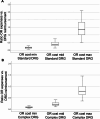Surgical treatment of posttraumatic spinal cord tethering and syringomyelia: a retrospective cohort investigation of cost, reimbursement, and financial sustainability
- PMID: 39567909
- PMCID: PMC11577722
- DOI: 10.1186/s12893-024-02672-0
Surgical treatment of posttraumatic spinal cord tethering and syringomyelia: a retrospective cohort investigation of cost, reimbursement, and financial sustainability
Abstract
Background: Posttraumatic spinal cord tethering and syringomyelia are considered disabling diseases in patients with spinal cord injury. In symptomatic patients, surgical management can achieve promising clinical outcomes. As the raising economic pressure might jeopardize optimal and thus personalized patient care, we aimed to exemplify expenses of surgical treatment in contrast to reimbursement by the Swiss diagnosis related group (DRG) system.
Methods: This retrospective investigation includes 60 patients who underwent surgery for spinal cord tethering and syringomyelia. The duration of surgeries was used to estimate the costs of care in the operating room (OR) considering established bench marks. Coverage of costs was calculated by comparing Swiss DRG reimbursements with the expenses from the investigated cases.
Results: The mean duration of surgeries was 251.0 ± 93.5 min while 2.8 ± 1.4 vertebral segments were treated by spinal cord untethering. The mean OR costs (in USD) were $9,401.2±$3,500.2 (range $4,119.5 to $20,223.0). The mean reimbursement and the ratio of OR costs to reimbursement (in USD) were $24,122.5±$7,409.3 (range $17,249.8 to $31,977.1) and 0.41 ± 0.15 (range 0.14 to 0.74) for standard, and $39,106.0±$4,028.6 (range $35,369.1 to $43,376.8) and 0.24 ± 0.08 (range 0.10 to 0.47) for complex cases, respectively. The estimated costs of surgeries were different from reimbursements (p = 0.005).
Conclusions: Although the cost of surgical management of patients with posttraumatic spinal cord tethering and syringomyelia are principally covered, it remains questionable if total hospital expenses are sufficiently outweighed by the current reimbursement system. This could potentially limit the availability of best medical care and might endanger personalized patient management.
Keywords: Diagnosis related groups; Economic; Personalized care; Posttraumatic; Spinal cord tethering; Syringomyelia.
© 2024. The Author(s).
Conflict of interest statement
Declarations. Ethics approval and consent to participate: All procedures performed in this study were in accordance with the ethical standards of the institutional review board/local ethics committee (Ethikkommission Nordwest- und Zentralschweiz, EKNZ; approval: KEK-2021-00890) and with the Helsinki Declaration (as revised in 2013). The need for written informed consent for further use of patient’s medical records for research purposes has been waived by the local ethics committee due to the pure retrospective design of the study. Consent for publication: Not applicable. Competing interests: The authors declare no competing interests.
Figures


Similar articles
-
Spinal cord tethering and syringomyelia after trauma: impact of age and surgical outcome.Sci Rep. 2023 Jul 15;13(1):11442. doi: 10.1038/s41598-023-38565-0. Sci Rep. 2023. PMID: 37454226 Free PMC article.
-
Posttraumatic spinal cord tethering and syringomyelia: surgical treatment and long-term outcome.J Neurosurg Spine. 2009 Oct;11(4):445-60. doi: 10.3171/2009.4.SPINE09333. J Neurosurg Spine. 2009. PMID: 19929342
-
Treatment of posttraumatic syringomyelia.J Neurosurg Spine. 2012 Sep;17(3):199-211. doi: 10.3171/2012.5.SPINE11904. Epub 2012 Jul 13. J Neurosurg Spine. 2012. PMID: 22794351
-
Radiographic assessment of surgical treatment of post-traumatic syringomyelia.J Spinal Cord Med. 2021 Nov;44(6):861-869. doi: 10.1080/10790268.2020.1743086. Epub 2020 Mar 30. J Spinal Cord Med. 2021. PMID: 32223591 Free PMC article. Review.
-
Treatment of posttraumatic syringomyelia: evidence from a systematic review.Acta Neurochir (Wien). 2020 Oct;162(10):2541-2556. doi: 10.1007/s00701-020-04529-w. Epub 2020 Aug 20. Acta Neurochir (Wien). 2020. PMID: 32820376 Free PMC article.
References
-
- Selvarajah S, Hammond ER, Haider AH, Abularrage CJ, Becker D, Dhiman N, et al. The burden of acute traumatic spinal cord injury among adults in the United States: an update. J Neurotrauma. 2014;31(3):228–38. - PubMed
-
- Bonfield CM, Levi AD, Arnold PM, Okonkwo DO. Surgical management of post-traumatic syringomyelia. Spine (Phila Pa 1976). 2010;35(21 Suppl):S245–58. - PubMed
-
- Lin W, Xu H, Duan G, Xie J, Chen Y, Jiao B, et al. Spine-shortening osteotomy for patients with tethered cord syndrome: a systematic review and meta-analysis. Neurol Res. 2018;40(5):340–63. - PubMed
-
- Klekamp J. Treatment of posttraumatic syringomyelia. J Neurosurg Spine. 2012;17(3):199–211. - PubMed
MeSH terms
LinkOut - more resources
Full Text Sources
Medical
Research Materials

